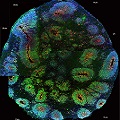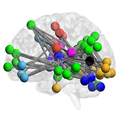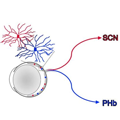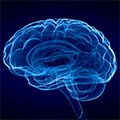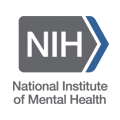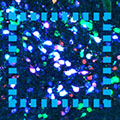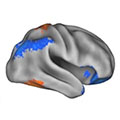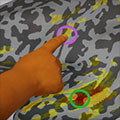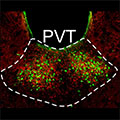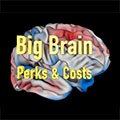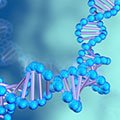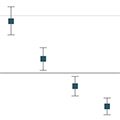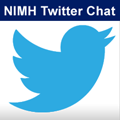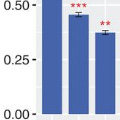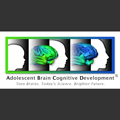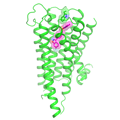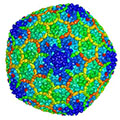Science Updates from 2018
- New Pathways for Implementing Universal Suicide Risk Screening in Healthcare Settings
-
A new report provides guidance on how to implement universal suicide risk screening of youth in medical settings. The report describes a way for hospitals to address the rising suicide rate in a way that is flexible and mindful of limited resources.
- 2,000 Human Brains Yield Clues to How Genes Raise Risk for Mental Illnesses
-
PsychENCODE researchers are discovering the biological mechanisms by which mental illness risk genes work in the human brain.
- Dynamic Associations Among Motor Activity, Sleep, Energy, and Mood Could Suggest New Focus for Depression Treatment
-
A new study looking at interactions among sleep, energy, activity level, and mood suggests that instability in activity and sleep systems could lead to mood changes. The findings suggest new targets for depression treatment.
- Studies Support Use of Team-Based Care for Early Psychosis
-
Two recent studies add to the evidence that team-based early intervention services are feasible in real-world health care settings and result in improved outcomes for patients.
- Hyperconnectivity in a Brain Circuit May Predict Psychosis
-
NIMH-funded scientists have discovered a pattern in the way a brain circuit works that may help predict the onset of psychosis. High levels of chatter, or “hyperconnectivity,” in a circuit involving the cerebellum, thalamus, and cortex emerged as a potential “neural signature” in a functional magnetic resonance imaging (fMRI) study.
- Team-based Care Optimizes Medication Treatment for First Episode Psychosis
-
Findings from NIMH’s Recovery After an Initial Schizophrenia Episode (RAISE) project indicate that team-based coordinated specialty care (CSC) for first episode psychosis (FEP) results in more optimal prescribing of antipsychotics and fewer side effects when compared with typical community care.
- NIMH Explores the “Next Big Thing” in Mental Health Services Research
-
The National Institute of Mental Health (NIMH)’s 24th biennial Mental Health Services Research (MHSR 2018) conference held August 1-2, in Rockville, MD, brought together mental health researchers, trainees, consumers, advocates, and mental health care providers to learn about current research findings and discuss new research that might close the gap between what science shows is most effective and what services people actually receive in real-world settings.
- NIMH Addresses Strategies for Suicide Prevention in Live Event
-
During NIMH’s Facebook Live event held in recognition of Suicide Prevention Week, NIMH Director Dr. Joshua Gordon and Dr. Jane Pearson, chair of the Suicide Research Consortium in NIMH’s Division of Services and Intervention Research, discussed some of the most recent suicide prevention research findings from NIMH, warning signs, and prevention strategies.
- The Pathways Through which Light Affects Learning and Mood
-
In a new study, researchers have traced the brain pathways responsible for the effects of light on learning and mood. The findings revealed that these effects are brought about by two different and distinct pathways from the retina into the brain.
- NIH Greatly Expands Investment in BRAIN Initiative
-
The National Institutes of Health announces funding of more than 200 new awards, totaling over $220 million, through the Brain Research through Advancing Innovative Neurotechnologies (BRAIN) Initiative, an exciting trans-agency effort to arm researchers with revolutionary tools to fundamentally understand the neural circuits that underlie the healthy and diseased brain.
- NIH Directors Address Chronic Pain and Opioid Crisis at Annual Society for Neuroscience Meeting
-
On Tuesday, Nov. 6, 2018, at a press conference at the Society for Neuroscience’s annual Meeting, National Institutes of Health directors will discuss how NIH is marshalling resources, primarily through the HEAL (Helping to End Addiction Long-term) Initiative, to come up with short- and long-term solutions for countering the pain and opioid crisis.
- NIH BRAIN Initiative Debuts Cell Census of Mouse Motor Cortex – for Starters
-
NIH BRAIN Initiative Cell Census Network (BICCN) has debuted its first data release, which focuses on motor cortex. In a related development, researchers have discovered cellular secrets of key social behaviors – mating, parenting, and aggression – in mouse hypothalamus.
- Understanding the Brain Mechanisms of Irritability in Youth
-
Researchers have identified differences in how the brains of irritable youth react to frustration, findings that could provide new paths for developing treatments for children and adolescents with severe irritability.
- NIMH Director Joshua Gordon and IRP Researcher Ellen Leibenluft Elected to the National Academy of Medicine
-
Joshua A. Gordon, M.D., Ph.D., director of the National Institute of Mental Health (NIMH), and Ellen Leibenluft, M.D., chief of the Section on Mood Dysregulation and Neuroscience and co-chief of the Emotion and Development Branch in the NIMH Intramural Research Programs, have been elected as members of the National Academy of Medicine.
- Media Advisory: NIMH Researchers Available to Discuss the Suicide Prevention Research
-
For National Suicide Prevention Awareness Month, NIMH Director Dr. Joshua Gordon and Dr. Jane Pearson, chair of the Suicide Research Consortium at the NIMH, are available for interviews on suicide prevention research, trends, and the findings and implications of recent studies.
- A Shorter—but Effective—Treatment for PTSD
-
Research supported by the National Institute of Mental Health has shown that a shorter therapy (written exposure therapy) may be just as effective as lengthier first-line treatments for PTSD.
- Inflammation in Pregnant Moms Linked to Child’s Brain Development
-
High levels of maternal inflammation during pregnancy have been linked to effects in children, including reduced brain circuit communications and altered long-distance brain wiring at birth, poorer cognitive function at one year – and to reduced impulse control and working memory at two years.
- “Covert” Neurofeedback Tunes-up the Social Brain in ASD
-
Young people with autism unknowingly tuned up flagging neural connections by playing a picture puzzle game that was rigged by their own brain activity.
- New Toolkit Offers Ways to Evaluate Suicide Prevention Efforts in Arctic Communities
-
The National Institute of Mental Health (NIMH), in collaboration with the Mental Health Innovation Network and other federal partners, has released the RISING SUN toolkit to help clinicians, communities, policymakers, and researchers measure the impact and effectiveness of suicide prevention efforts in rural and tribal communities.
- Predicting Suicide Attempts and Suicide Deaths Using Electronic Health Records
-
Researchers have developed a new prediction model that substantially outperforms existing self-report tools used to predict an individual’s risk of a suicide attempt or dying by suicide.
- Understanding Critical Components of the Brain’s Stress Circuitry
-
A new study has revealed more about the organization and function of a brain structure—the paraventricular nucleus of the thalamus—that may serve a key role in linking stress detection to the development of adaptive behaviors.
- Targeted E-Health HIV Intervention Reduces STIs and Sexual Risk Behaviors
-
Findings from a new study suggest an electronically delivered HIV prevention intervention may be effective in reducing sexually transmitted infections (STIs) and sexual risk behaviors in young men who have sex with men.
- NIMH Releases Updates to its RDoC Framework
-
The Research Domain Criteria (RDoC) is a dynamic and continually developing framework for studying mental disorders. Now, the RDoC Unit has unveiled changes to the RDoC framework–a reorganization of content within the Positive Valence domain.
- Therapy Reduces Risk in Suicidal Youth
-
A recent clinical trial of a psychotherapy called dialectical behavior therapy (DBT)—which has been shown to be effective in reducing suicide-related behavior in adults—showed that DBT can also reduce suicide attempts and suicidal behavior in adolescents.
- Intervention Shows Promise for Treating Depression in Preschool-Aged Children
-
Researchers funded by the National Institutes of Health have shown that a therapy-based treatment for disruptive behavioral disorders can be adapted and used as an effective treatment option for early childhood depression.
- Delay in HIV Treatment Associated with Brain Atrophy
-
People infected with the human immunodeficiency virus, known as HIV, display reductions in brain volume compared with people who are not infected with HIV, but now an NIMH-funded study has shed light on the course of this deterioration and shows that antiretroviral treatment started in the first few years of infection may stop these brain changes.
- Suicide: How You Can Make a Difference
-
The recent deaths of Kate Spade and Anthony Bourdain have brought the topic of suicide into everyday conversations. It’s important to know some facts and to know what to do if you think someone might be at risk for self-harm.
- Bigger Human Brain Prioritizes Thinking Hub – at a Cost
-
Scientists have discovered that bigger human brains are organized differently than smaller ones.
- Inherited Variations in Noncoding Sections of DNA Associated with Autism
-
A new study has identified an association between paternally-inherited rare structural variants in noncoding segments of genes and the development of autism spectrum disorder (ASD). The study adds to a growing body of research describing genetic contributors to ASD.
- Age-Related Racial Disparity in Suicide Rates Among U.S. Youth
-
Researchers have discovered an age-related racial disparity in suicide rates for U.S. youth between the ages of 5 and 17. The findings suggest a need for more research into contributing factors and targeted interventions for children.
- NIMH Conference to Explore Mental Health Services Research
-
On August 1-2, 2018, the NIMH is hosting the 24th Mental Health Services Research (MHSR) Conference with the theme: What’s the Next Big Thing? The conference aims to promote high-priority areas in mental health services research and identify opportunities with potential for significant impact for people with mental disorders.
- New Processing Technique Helps Researchers Use Electronic Health Records to Study Biological Contributors to Mental Illnesses
-
Researchers have found a way to scan electronic health records that helps identify associations between broad RDoC-based dimensions of behavioral function and biological contributors to mental illnesses.
- NIMH to Host Twitter Chat on Teen Depression
-
On May 3, 2018, join NIMH for a Twitter chat on teen depression with experts Dr. Argyris Stringaris and Dr. Ken Towbin.
- Hubs Help Native American Communities Address Youth Suicide
-
Three NIMH-funded collaborative research hubs are exploring the factors behind the high suicide rates among American Indian (AI) and Alaska Native (AN) youth and designing and testing approaches to preventing suicide.
- Suspect Molecules Overlap in Autism, Schizophrenia, Bipolar Disorder
-
Depression, schizophrenia and autism spectrum disorder share some of the same patterns of suspect gene expression – molecular signatures.
- NIMH’s Dr. Ann Wagner Designated as the National Autism Coordinator
-
NIMH’s Dr. Ann Wagner has been designed as the National Autism Coordinator. In this role, she will play a vital role in ensuring the implementation of national autism spectrum disorder research, services, and support activities across federal agencies.
- NIH Releases First Dataset from Unprecedented Study of Adolescent Brain Development
-
The National Institutes of Health released to the scientific community an unparalleled dataset from the Adolescent Brain Cognitive Development (ABCD) study.
- NIMH Twitter Chat on Seasonal Affective Disorder
-
On February 20, 2018, join NIMH for a Twitter chat on Seasonal Affective Disorder with expert Dr. Matthew Rudorfer.
- Molecular Secrets Revealed: Antipsychotic Docked in its Receptor
-
Scientists have deciphered the molecular structure of a widely-prescribed antipsychotic docked in its key human brain receptor. The discovery may hold clues to designing better treatments for schizophrenia, bipolar disorder and other mental illnesses.
- Memory Gene Goes Viral
-
A gene crucial for learning can send its genetic material from one neuron to another by employing a strategy commonly used by viruses.
- Intramural Researchers Develop Suicide Risk Screening Toolkit for Medical Settings
-
NIMH researchers have developed a brief screening questionnaire for medical professionals to identify youth at risk for suicide.


